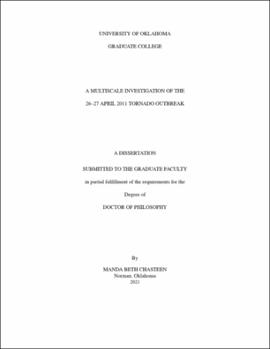| dc.description.abstract | One of the most prolific tornado outbreaks ever documented occurred on 26–27 April 2011 and comprised three successive episodes of tornadic convection that primarily impacted the southeastern United States, including two quasi-linear convective systems (hereafter QLCS1 and QLCS2) that preceded the notorious outbreak of long-track, violent tornadoes spawned by numerous supercells over the warm sector during the afternoon and evening of 27 April. The ~36-h period encompassing these three convective episodes was part of a longer multiday outbreak that occurred ahead of a highly amplified and slowly moving upper-level trough as three embedded shortwaves supported destabilization and episodic convective development over the south-central U.S.
This research employs a combination of observational datasets, operational models, and convection-permitting WRF-ARW simulations to provide a multiscale investigation of the 26–27 April 2011 tornado outbreak. Particular attention is given to 1) identifying the mesoscale processes that contributed to the initiation, organization, and morphological evolution of each of the three convective episodes; 2) evaluating how the environmental conditions evolved throughout the outbreak to support three successive convective episodes with differing severities and modalities; and 3) assessing how the environment was altered by latent processes occurring within the first two convective episodes and how these upscale environmental modifications influenced the overall severity and evolution of this multiepisode outbreak.
Herein we demonstrate that the second shortwave in the sequence moved into the southern Great Plains (SGP) prior to the formation of QLCS1 on the evening of 26 April, while the third and most predominant shortwave—which was attended by an exceptionally strong upper-level jet streak, deep tropopause fold, and Pacific cold front that evolved into a cold front aloft (CFA) as it moved downslope over Texas and ultimately acquired the character of a dryline at the surface—supported both the development of QLCS2 and the afternoon supercell outbreak that subsequently unfolded over the Southeast. The development of QLCS1 was immediately followed by unbalanced upper-level jetogenesis, rapid amplification of the large-scale flow pattern, considerable intensification of the low-level jet (LLJ) and vertical wind shear over the warm sector, and secondary surface cyclogenesis over the Midwest. The dramatic flow modifications stemming from this system contributed to both its rapid upscale growth and exceptional severity and persisted throughout the remainder of the outbreak. QLCS2 produced additional modifications to the mesoscale environment over the Southeast by promoting the downstream formation of a pronounced upper-level jet streak, altering the midlevel jet structure, furthering the development of a highly ageostrophic LLJ, and reinforcing a convectively generated thermal boundary that behaved as an effective warm front. Finally, the prolific afternoon supercell outbreak commenced as the third shortwave moved into the Lower Mississippi Valley and convection erupted primarily—but not exclusively—along two bands that were associated with the dryline and preceding CFA. The upscale flow modifications collectively produced by both antecedent QLCSs contributed to the notably favorable shear profiles present over the warm sector at the beginning of the supercell outbreak. Although the thermodynamic environment over the Southeast was also influenced by outflow from the two QLCSs, rapid destabilization occurred throughout the morning in response to surface heating, strong differential advection, and mesoscale lifting by prefrontal disturbances that were triggered ahead of the CFA. Ultimately, the unique overlap of anomalously large buoyancy, highly favorable vertical shear profiles, and the mesoscale organization of numerous supercells that remained largely discrete for several hours as they traversed the warm sector enabled this final and most devastating tornadic episode. | en_US |
